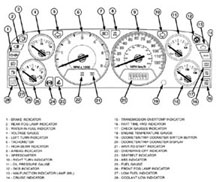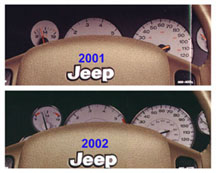Electroluminescent gauges technical description:
This new instrument cluster is an ElectroMechanical Instrument Cluster (EMIC) module. The EMIC, including the mounts and the electrical connections, are concealed behind the cluster bezel. The EMIC gauges and indicators are protected by an integral clear plastic cluster lens, and are visible through a dedicated hooded opening in the instrument panel top pad. Just behind and integral to the cluster lens are the cluster hood and cluster mask, which are constructed of molded black plastic.
Two cluster masks are used: A base version features a black matte face and no trim ring around the perimeter of each gauge opening, while a premium version features a black matte face and a raised trim ring around the perimeter of each gauge opening. The cluster hood serves as a visor and shields the face of the cluster from ambient light and reflections to reduce glare, while the cluster mask serves to separate and define the individual gauges of the EMIC.
The cluster mask features two large round openings near its center through which the two major gauges are visible, and two smaller round openings stacked at the outboard side of each of the large openings through which the four minor gauges are visible. The cluster mask and the dial faces of the gauges are laminated plastic units. The dark, visible surface of the mask and the gauge dial faces are the outer layer or overlay, which is translucent. The darkness of this outer layer prevents the cluster from appearing too cluttered or busy by concealing the cluster indicators that are not illuminated, while the translucence of this layer allows those indicators and 1 icons that are illuminated to be readily visible. The underlying layer of the cluster mask overlay is opaque and allows light from the various indicators behind it to be visible through the outer layer of the mask and gauge dial faces only through predetermined cutouts.
On the base instrument clusters the graphics, increments, and numerals on the gauge faces are also translucent and illuminated from behind, while the orange gauge pointers are illuminated internally. On the premium instrument clusters the graphics, increments, numerals and gauge needles are opaque while the remainder of the gauge faces are translucent and illuminated from behind by an electroluminescent lamp. The EMIC electronic circuitry is protected by a molded plastic rear cover that features several round access holes for service of the incandescent cluster indicator and illumination lighting lamps and a large rectangular access hole for the EMIC connector receptacle.




